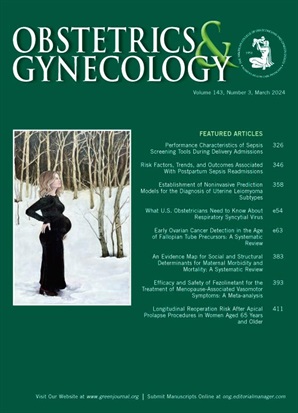胎盘增生谱系障碍的循证围手术期治疗。
IF 5.7
2区 医学
Q1 OBSTETRICS & GYNECOLOGY
引用次数: 0
摘要
胎盘增生谱(PAS)障碍,其特征是分娩后异常附着的胎盘不能从子宫脱离,是严重孕产妇发病率的主要原因。尽管其发病率相对较低,但与围产期出血、大量输血和紧急子宫切除术不成比例的贡献强调了开发循证外科治疗PAS策略的迫切需要。对于贫血的术前管理,以及术中血液制品和细胞抢救复苏的准备,有明显的益处。在PAS分娩中应保持正常剖宫产的几个原则,如在分娩前使用轴向麻醉,预防性抗生素,术中机械血栓预防,以及在发生大量出血时给予氨甲环酸。PAS独特的外科治疗要素和公认的最佳实践包括:当产前怀疑PAS时,在有经验的团队的中心计划分娩,术中进入腹腔时进行全面的子宫和盆腔检查,以评估解剖扭曲或血管异常,选择远离胎盘边缘的子宫切开术地点分娩,以及在新生儿分娩后和子宫复合开始时直接目视评估胎盘与子宫肌层的关系。其他降低发病率的策略,如常规膀胱镜检查伴输尿管支架置入或不伴输尿管支架置入、非常规腹腔横贯入路、手术吻合器子宫切开扩张、血管内出血减少策略(包括主动脉或髂球囊闭塞和多血管动脉栓塞)仍处于实验阶段,需要进一步研究。本文章由计算机程序翻译,如有差异,请以英文原文为准。
Evidence-Based Perioperative Management of Placenta Accreta Spectrum Disorder.
Placenta accreta spectrum (PAS) disorder, characterized by failure of the abnormally adherent placenta to detach from the uterus after delivery, is a leading cause of severe maternal morbidity. Despite its relatively low incidence, disproportional contributions to perinatal hemorrhage, massive transfusion, and emergency hysterectomy underscore the critical need for development of evidence-based surgical management strategies for PAS. There is clear benefit to preoperative management of anemia, as well as preparation for intraoperative resuscitation with blood products and cell salvage. Several tenets of normal cesarean delivery should be maintained in PAS delivery such as the use of neuraxial anesthesia until delivery, prophylactic antibiotics, mechanical thromboprophylaxis intraoperatively, and administration of tranexamic acid if excessive bleeding occurs. Elements of surgical management distinctive to PAS and accepted as best practice include the following: planning delivery at centers with experienced teams when PAS is suspected antenatally, global intraoperative uterine and pelvic survey on entry into the abdominal cavity to assess for anatomic distortion or abnormal vascularity, selection of hysterotomy site for delivery well away from the placental margin, and direct visual assessment of the placental relationship with the myometrium after neonatal delivery and during the start of uterine involution. Other morbidity-reducing strategies such as routine cystoscopy with or without ureteral stent placement, unconventional transverse abdominal entry, hysterotomy extension with surgical staplers, and endovascular hemorrhage reduction tactics involving aortic or iliac balloon occlusion and multivessel arterial embolization remain experimental and require further research.
求助全文
通过发布文献求助,成功后即可免费获取论文全文。
去求助
来源期刊

Obstetrics and gynecology
医学-妇产科学
CiteScore
11.10
自引率
4.20%
发文量
867
审稿时长
1 months
期刊介绍:
"Obstetrics & Gynecology," affectionately known as "The Green Journal," is the official publication of the American College of Obstetricians and Gynecologists (ACOG). Since its inception in 1953, the journal has been dedicated to advancing the clinical practice of obstetrics and gynecology, as well as related fields. The journal's mission is to promote excellence in these areas by publishing a diverse range of articles that cover translational and clinical topics.
"Obstetrics & Gynecology" provides a platform for the dissemination of evidence-based research, clinical guidelines, and expert opinions that are essential for the continuous improvement of women's health care. The journal's content is designed to inform and educate obstetricians, gynecologists, and other healthcare professionals, ensuring that they stay abreast of the latest developments and best practices in their field.
 求助内容:
求助内容: 应助结果提醒方式:
应助结果提醒方式:


